
Uptown is one of Chicago's 77 community areas. Uptown's boundaries are Foster Avenue on the north; Lake Michigan on the east; Montrose, and Irving Park on the south; Ravenswood, and Clark St on the west. To the north is Edgewater, to the west is Lincoln Square, and to the south is Lakeview.

Graceland Cemetery is a large historic garden cemetery located in the north side community area of Uptown, in Chicago, Illinois, United States. Established in 1860, its main entrance is at the intersection of Clark Street and Irving Park Road. Among the cemetery's 121 acres (49 ha) are the burial sites of several well-known Chicagoans.

Jens Jensen was a Danish-American landscape architect.

Prairie School is a late 19th- and early 20th-century architectural style, most common in the Midwestern United States. The style is usually marked by horizontal lines, flat or hipped roofs with broad overhanging eaves, windows grouped in horizontal bands, integration with the landscape, solid construction, craftsmanship, and discipline in the use of ornament. Horizontal lines were thought to evoke and relate to the wide, flat, treeless expanses of America's native prairie landscape.
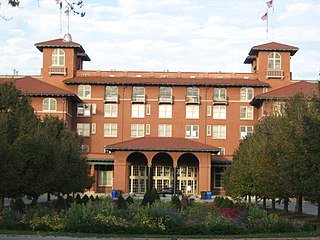
The South Shore Cultural Center, in Chicago, Illinois, is a cultural facility located at 71st Street and South Shore Drive, in the city's South Shore neighborhood. It encompasses the grounds of the former South Shore Country Club.

National Park Service rustic – sometimes colloquially called Parkitecture – is a style of architecture that developed in the early and middle 20th century in the United States National Park Service (NPS) through its efforts to create buildings that harmonized with the natural environment. Since its founding in 1916, the NPS sought to design and build visitor facilities without visually interrupting the natural or historic surroundings. The early results were characterized by intensive use of hand labor and a rejection of the regularity and symmetry of the industrial world, reflecting connections with the Arts and Crafts movement and American Picturesque architecture.
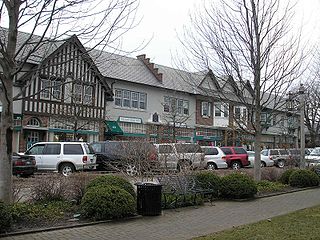
Howard Van Doren Shaw AIA was an architect in Chicago, Illinois. Shaw was a leader in the American Craftsman movement, best exemplified in his 1900 remodel of Second Presbyterian Church in Chicago. He designed Marktown, Clayton Mark's planned worker community in Northwest Indiana.

The Emil Bach House is a Prairie style house in the Rogers Park neighborhood of Chicago, Illinois, United States that was designed by architect Frank Lloyd Wright. The house was built in 1915 for an admirer of Wright's work, Emil Bach, the co-owner of the Bach Brick Company. The house is representative of Wright's late Prairie style and is an expression of his creativity from a period just before his work shifted stylistic focus. The Bach House was declared a Chicago Landmark on September 28, 1977, and was added to the U.S. National Register of Historic Places on January 23, 1979.

The Flamingo-on-the-Lake Apartments, also known as the Flamingo Apartment Hotel, is a building designed by architect William C. Reichert and located at 5500-5520 S. Shore Drive along Lake Michigan in the Hyde Park neighborhood of Chicago, Illinois. The 16-story apartment building was built with 144 apartments and 16 hotel rooms in 1927; it also featured an outdoor pool and bathhouse. It was designed in the Classical Revival style; its exterior is red brick with terra cotta ornamentation and a dentillated cornice. It and the adjacent building, The Promontory Apartments, a co-op building designed by Mies van der Rohe, are the furthest east buildings in Hyde Park.
Lake Cook Road is a major east–west highway in Cook, Lake, McHenry, and Kane Counties in Illinois. For much of its length, it marks the border between Cook and Lake Counties, hence the name of the road. In its western stretch, it marks the border between McHenry and Cook Counties, and further west, McHenry and Kane Counties. The road is approximately 25.5 miles (41.0 km) in length, from its western terminus at Illinois Route 62 in Algonquin to its eastern terminus at Sheridan Road in Highland Park and Glencoe, near Lake Michigan. The road is notable for its cross-section of Chicago's northern suburbs, balancing densely developed commercial, industrial, and residential land uses, with open space areas such as forest preserves, parks, golf courses, creeks, rivers, gardens, and Lake Michigan.
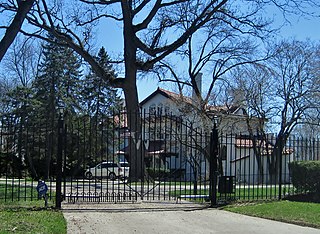
The Frank Hibbard Estate House is a historic house located at 301 North Chiltern Drive in the Deerpath Hill Estates development in Lake Forest, Illinois. The house was built in 1903 for Frank Hibbard of Hibbard, Spencer, Bartlett & Company, which later became True Value Hardware. Architect George Lyon Harvey designed the house in the Mediterranean Revival style; his design featured a terra cotta roof, decorative iron window coverings, and several porches. In 1929, developer Henry Turnbull purchased the property. Turnbull divided the property, which originally occupied a 21-acre (8.5 ha) plot, to create the Second Addition to Deerpath Hill Estates. Architect Stanley Anderson, a colleague of Turnbull and the developer of the original Deerpath Hill Estates, modernized the house in keeping with its Mediterranean design.

The Lake Hotel, also known as Lake Yellowstone Hotel is one of a series of hotels built to accommodate visitors to Yellowstone National Park in the late 19th and early 20th century. Built in 1891, it is the oldest operating hotel in the park. It was re-designed and substantially expanded by Robert Reamer, architect of the Old Faithful Inn in 1903. In contrast to the Old Faithful Inn and many other western park facilities, the Lake Hotel is a relatively plain clapboarded Colonial Revival structure with three large Ionic porticoes facing Yellowstone Lake. It was designated a National Historic Landmark in 2015.

The Mamakating Park Historic District is located on the ridge north of Masten Lake on the highest ground in the Town of Mamakating, New York, United States. It is a Catskill vacation community, originally intended to be the much larger Sullivan County Club, built in the 1890s.
Lawrence Buck (1865—1929) was a successful and influential Chicago area residential and commercial architect, artist and landscape painter, associated with the Prairie School and the American Arts and Crafts Movement.
Patton & Fisher was an architectural firm in Chicago, Illinois. It operated under that name from 1885 to 1899 and later operated under the names Patton, Fisher & Miller (1899–1901) and Patton & Miller (1901–1915). Several of its works are listed on the National Register of Historic Places.
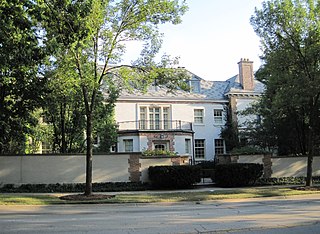
The Edward H. Bennett House and Studio is an architecturally significant house in Lake Forest, Illinois, United States. It was designed by and built for Edward H. Bennett, who is best known as an urban planner and architect who worked in association with Daniel Burnham.

The House at 965 Castlegate Court is a historic house located at 965 Castlegate Court in the Deerpath Hill Estates development in Lake Forest, Illinois. Developer Henry K. Turnbull, who planned the original section of Deerpath Hill Estates, built the house in 1930. The house is located at the northern entrance to the First Addition to Deerpath Hill Estates; it is technically outside of the development, and was marketed as being in the "Deerpath Hill Estates district". It is the only house Turnbull built outside of the original three sections of Deerpath Hill Estates; its location served to draw potential buyers into the estate from Waukegan Road. The house has a Colonial Revival design in keeping with the revivalist styles used in the development; its design features two stone-faced gables and a developed cornice.

Lake Forest Cemetery is a rural cemetery in Lake Forest, Illinois, United States. The site was first identified for burial in 1857 when the town of Lake Forest was planned. Later, William Le Baron Jenney designed a winding road system and Ossian Cole Simonds developed the landscape scheme.

Hotel St. Benedict Flats is a historic apartment building located at the northeast corner of Chicago Avenue and Wabash Avenue in the Near North Side neighborhood of Chicago, Illinois. Built in 1882, the building was one of the "French flat" luxury apartments constructed after the Great Chicago Fire; named for their resemblance to Parisian apartments, these new buildings brought apartment living to Chicago's upper class. The building was built by Loyola University with the intention to use the revenue to pay for healthcare for the poor. Architect James J. Egan, an Irish Catholic better known for his church designs, designed the Victorian Gothic building. The building's decorative features, such as its lintels, art glass windows, and use of pressed metal, were common features of contemporary upper-class homes, while its mansard roofs evoked French architecture. Egan named the building for the property's previous owners, the Order of Saint Benedict; the "Hotel" portion of the name was added to exploit a legal loophole, as the building never served as a hotel. The original doors still remain on the flats.
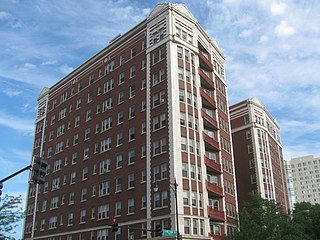
The East Park Towers are a historic apartment building at 5236-5252 S. Hyde Park Boulevard in the Hyde Park neighborhood of Chicago, Illinois. The building was constructed in 1922-23 during a period of residential growth in Hyde Park. While it had no guest rooms, the apartments offered similar amenities to an apartment hotel, such as housekeeping service. Apartment hotels were popular as part-time housing for wealthy workers, as they combined the amenities of in-home service with the affordability of apartments, and the East Park Towers were one of several such apartments built in Hyde Park at the time. Architect William P. Doerr designed the building in the Georgian Revival style; his design included terra cotta belt courses and quoins and Palladian windows on the first floor.



















